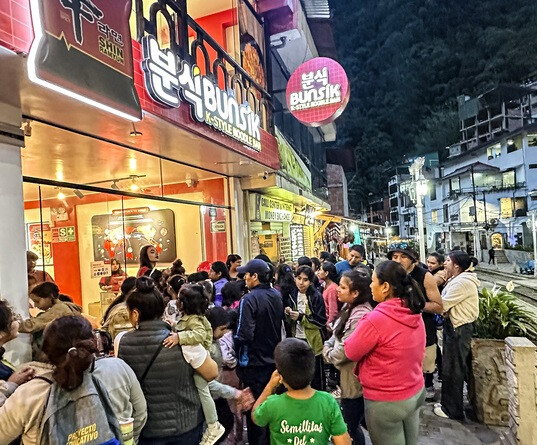
AGUAS CALIENTES, PERU - High in the Peruvian Andes, on the winding path leading to the ancient Inca citadel of Machu Picchu, an unexpected aroma now mingles with the crisp mountain air: the spicy, savory scent of Korean ramen. South Korean food giant Nongshim has recently inaugurated its "Shin Ramyun Snack Shop" in Aguas Calientes, the bustling town serving as the gateway to the famed archaeological site. Situated at an elevation of 2,400 meters – a height comparable to ten stacked 63 Building skyscrapers in Seoul – this outpost of Korean culinary culture offers global tourists a taste of South Korea's beloved instant noodles, complete with an adjacent museum chronicling the history of ramen.
This strategic move is part of Nongshim's ambitious plan to establish similar bunsikjeom (Korean snack shops) in other prominent tourist destinations worldwide by June, signaling a bold step in their global expansion strategy. The underlying rationale extends beyond mere sales; it's about creating an immersive experience for international consumers, allowing them to connect with Korean culture through its iconic noodle dish.
Nongshim has already demonstrated this approach through initiatives like the free distribution of Shin Ramyun at the Jungfraujoch in Switzerland. Perched high in the Alps, the picturesque setting provides a memorable backdrop for first-time encounters with Korean ramen, transforming a simple meal into a cultural anecdote shared widely among travelers. This initiative has proven remarkably successful, with enjoying Shin Ramyun against the stunning Alpine vista becoming a popular activity for tourists.
This proactive engagement aligns with the burgeoning global appetite for Korean ramen, fueled significantly by the international success of South Korean cultural content, often referred to as the "Korean Wave" or "Hallyu." Over the past decade, South Korea's ramen exports have witnessed consistent year-on-year growth. The figures for 2024 underscore this trend dramatically, reaching a staggering 1.81 trillion KRW (approximately 1.35 billion USD), marking a 30% surge from the previous year. The momentum has continued into 2025, with exports already surpassing 500 billion KRW by March, setting a new historical record.
The correlation between the popularity of Korean dramas, films, and music and the increased interest in Korean cuisine is undeniable. As global audiences embrace Korean entertainment, their curiosity naturally extends to the food and flavors depicted on screen. Ramen, often featured prominently in these productions, has become a readily accessible and appealing entry point into Korean gastronomy.
Data from the Korea Agro-Fisheries & Food Trade Corporation (aT) further illustrates this global demand. The United States, the Netherlands, and China consistently rank as the top importers of South Korean ramen, reflecting its widespread appeal across diverse palates. This robust international demand has spurred Korean ramen manufacturers to adopt more localized strategies. Recognizing that taste preferences vary across regions, companies like Nongshim, Samyang Foods, and Ottogi are increasingly investing in research and development to create product variations tailored to local culinary norms. This includes adjusting spice levels, incorporating regional ingredients, and even developing entirely new flavor profiles.
Furthermore, some companies are exploring the establishment of their own retail networks overseas, moving beyond traditional supermarket placements to create dedicated spaces where consumers can fully experience their brands. These smaller-scale marts offer a wider range of products, including niche and limited-edition items, and often serve as cultural touchpoints, further solidifying the connection between the brand and international consumers.
The strategic placement of a bunsikjeom at a globally significant location like Machu Picchu is a testament to the evolving landscape of food globalization. It signifies a move beyond simply exporting products to actively curating cultural experiences centered around Korean cuisine. By embedding themselves within iconic international landmarks, Korean food companies are not only tapping into the flow of global tourism but also strategically positioning their products within memorable and shareable moments, further amplifying the reach and impact of the Korean food wave. As Nongshim continues its expansion into other popular tourist destinations, the aroma of Korean ramen is poised to become an increasingly familiar and welcome scent in diverse corners of the world, solidifying its place as a truly global food phenomenon.
[Copyright (c) Global Economic Times. All Rights Reserved.]






























